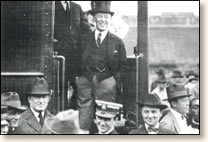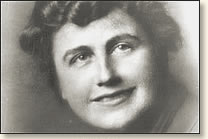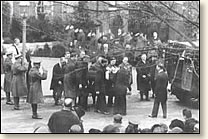|
President Wilson
Suffers a Stroke, 1919
Woodrow Wilson successfully sold his concept of a League of Nations to the European powers who included it in the Versailles Treaty. He had more difficulty convincing the Senate. Conservative Senators (the "irreconcilables") blocked ratification of a treaty that included provisions for a League. Wilson decided to go over their

Wilson on his whirl-wind tour to
sell the nation on his concept
of a League of Nations
|
heads by appealing directly to the American people through a cross-country speaking tour. The proposal upset Wilson's physician, Dr. Grayson, who pleaded with the President to reconsider. He argued that Wilson had not yet recovered from the Paris Peace Conference, and that as a man of 60, he could not ignore his health. His argument fell on deaf ears. "I do not want to do anything foolhardy," the President responded, "but the League of Nations is now in its crisis, and if it fails, I hate to think what will happen to the world ... I cannot put my personal safety, my health, in the balance against my duty -- I must go."
A special train left Washington on September 3 making stops all across the country. The President appeared on the rear platform, delivered a speech to the gathered crowd, and the train then sped on to the next stop. It was a grueling schedule and it began to take its toll on Wilson's health. Severe asthma attacks and splitting headaches started in Montana. In Colorado, his headaches almost blinded him. Finally in Wichita, his doctor found Wilson close to a "complete breakdown." On September 26, the train sped back to Washington to give Wilson a rest.
On the morning of October 2, Mrs. Wilson found her husband unconscious on the bathroom floor of their private White House quarters bleeding from a cut on his head. Wilson had suffered a stroke - a massive attack that left his left side paralyzed and impaired his vision. She immediately summoned Dr. Grayson. Then the conspiracy began. The two of them formed a bulwark between the invalid President and the rest of the country, simultaneously shielding Wilson from intrusion and hiding his condition from outsiders.
For seventeen months the enfeebled President lay in his bed on the brink of death, barely able to write his own name. The outside world knew none of this. All communication with the President went through his wife. She entered the sick room with messages and emerged with verbal instructions or the scrawl of a signature on a piece of paper. Edith Wilson called the period her "stewardship." Later, others called her the first woman President. The Senate rejected the Treaty of Versailles with its provision for the League. Although Wilson's health improved, he never fully recovered.
Ike Hoover served as Wilson's Chief Usher and was responsible for managing the everyday activities of the presidential mansion. Hoover had accompanied Wilson on his trip to the Paris Peace Conference where he first become alarmed at changes in the President's behavior and suspected his health was failing.
Hoover recounts what happened that fateful morning of October 2:
"At exactly ten minutes before nine o'clock on this memorable day (I noted the time in writing the same day), my telephone on the desk in the Usher's Room at the White House rang and Mrs. Wilson's voice said, 'Please get Doctor Grayson, the President is very sick.' The telephone used was a private one that did not go through the general telephone switchboard. Mrs. Wilson had come all the way out to the end of the upper hall to use this particular telephone instead of the regular one in their bedroom. I reasoned at the time that it was done to avoid publicity, for there had been talk about the

Edith Wilson
|
operators of the switchboard listening in and distributing information they picked
up. I immediately called Doctor Grayson at his home, repeated the message as
Mrs. Wilson had given it to me, and ordered one of the White House automobiles
to go for him with all haste. I then went upstairs to see if there was anything
I could do.
...I waited up there until Doctor Grayson came, which was but a few minutes at
most. A little after nine, I should say, Doctor Grayson attempted to walk right
in,
but the door was locked. He knocked quietly and, upon the door being opened,
he entered. I continued to wait in the outer hall. In about ten minutes Doctor
Grayson came out and with raised arms said, 'My God, the President is paralyzed!
Send for Doctor Stitt and the nurse.'
...The second doctor and nurse arrived and were shown to the room. The employees
about the place began to get wise to the fact that the President was very ill,
but they could find out nothing more. Other doctors were sent for during the
day, and the best that could be learned was that the President was resting
quietly. Doctor Davis of Philadelphia and Doctor Ruffin, Mrs. Wilson's personal
physician, were among those summoned. There were doctors everywhere.
A consultation of them all together was held about four o'clock. An air of secrecy had come over things during the day. Those on the outside, including family and employees, could learn nothing. It was my privilege to go into the sick-room in the late afternoon. Some rearrangement of the furnishing had to be made and the domestic attendants on the floor were not allowed in. So Doctor Grayson, the nurse, and I did the job.
The President lay stretched out on the large Lincoln bed. He looked as if he were dead. There was not a sign of life. His face had a long cut about the temple from which the signs of blood were still evident. His nose also bore a long cut lengthwise. This too looked red and raw. There was no bandage.
Soon after, I made confidential inquiry as to how and when it all happened. I was told - and know it to be right - that he had gone to the bathroom upon arising in the morning and was sitting on the stool when the affliction overcame him; that he tumbled to the floor, striking his head on the sharp plumbing of the bathtub in his fall; that Mrs. Wilson, hearing groans from the bathroom,

Wilson's funeral , February 1924 |
went in and found him in an unconscious condition. She dragged him to the bed in the room adjoining and came out into the hall to call over the telephone for the doctor, as I have related.
For the next three or four days the White House was like a hospital. There were all kinds of medical apparatus and more doctors and more nurses. Day and night this went on. All the while the only answer one could get from an inquiry as to his condition was that it 'showed signs of improvement.' No details, no explanations. This situation seemed to go on indefinitely. It was perhaps three weeks or more before any change came over things. I had been in and out of the room many times during this period and I saw very little progress in the President's condition. He just lay helpless. True, he had been taking nourishment, but the work the doctors had been doing on him had just about sapped his remaining vitality. All his natural functions had to be artificially assisted and he appeared just as helpless as one could possibly be and live."
References:
Hoover, Irwin Hood, Forty-two Years in the White House (1934); MacMahon, Edward and Leonard Curry, Medical Cover-Ups in the White House (1987); Smith, Gene, When the Cheering Stopped; the Last Years of Woodrow Wilson (1964).
How To Cite This Article:
"President Wilson Suffers a Stroke, 1919," EyeWitness to History www.eyewitnesstohistory.com (2002).
|






